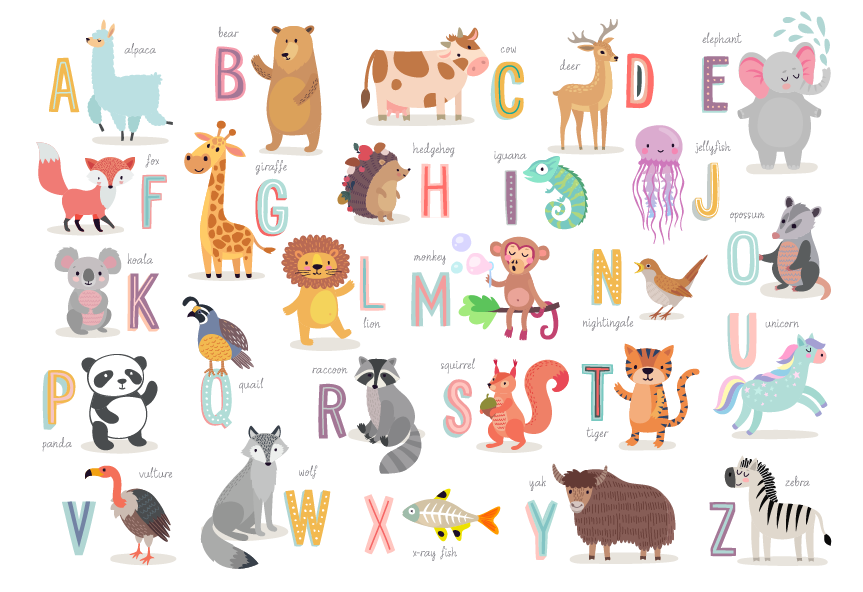On the Jade Emperor’s orders, Divine Officer Youyi and Immortal Master Yi traveled directly to the foothills of Soul Mountain, to the opulent Thunderclap Monastery and paid their respects to the four guardians1 and eight bodhisattvas and troubled them to pass on their message. The messengers followed the bodhisattvas to the gilded Lotus Platform atContinue reading “Journey to the West – Chapter 7.2”
Tag Archives: etymology
Piano no Mori – Numbers are Weird
Looking up the etymology for this page, I got really distracted by 一 and 二. These two kanji (meaning 1 and 2) are two of the simplest characters that exist and, along with 三 (3), some of the first kanji/characters that you learn1. However, numbers are one of the most complicated and confusing things I’ve tried to learn in Japanese. Each number has multiple pronunciations, and thus far to me, it’s not always clear which one to go with.
Alphabet Animals
When a culture encounters something new in a new place, such as during colonization, war, or mass migration, words tend to be borrowed quickly and wholesale so people can communicate new concepts. Animal words are a great example of this. Guess which of the following animal names you think are native to English. I’ve listed below the explanations for ones that are not.
Piano no Mori – Made-up Ceremonies
本物(honmono) means “the real deal.” 本(jap: hon, chi: ben3) means “origin” or “source”. The character is a tree – 木 – with a line through the base to highlight the root, or “source” of the tree. The word for Japan – 日本(jap: nihon, chi: ri4ben3) – is “the source of the sun”.
Piano no Mori – Stick Figures with Boobs
Kids in the US drawing stick figures usually distinguish women by their long hair, but that was not the strategy employed when developing this character. If you really squint at 女, you can see that there’s arms, legs, a head, and a kind of bulge in the middle of the body. What is that bulge? (It’s a boob).
Piano no Mori – Sassy Children are the Best Children
The nature of translation is that nuance will be lost. You want the text to be understood by people who live within a different cultural context and in a language with different sentence structures, idioms, and that sometimes just cannot convey all of the nuances and connotations in the original text. Reading this text in its original language, however clumsily and slowly I’m doing it, is shedding light on all of the color and connotation I’ve been missing. And I feel like I’m getting to know (and falling in love with) these characters all over again.
Piano no Mori – An Eye for a Head
人間(ningen) is the first time in this book we’ve seen the definitions deviate. In Japanese, 人間 means human being (in this context). In Chinese, 人間(ren2jian1) means “the human world”, as in the mortal realms. Breaking it down, we get 人 – person and 間 – space1. It seems what has happened in Japanese is that this started out as a Buddhist phrase: 人間界(ningenkai), meaning the human world in Buddhist cosmology. Perhaps, since 界 already means “world”, 人間 was taken to mean “human”.
Piano no Mori – No Discussion Needed
Lots of new kanji here, and also a fun phrase. もちろん(mochiron) is a super common Japanese phrase that means “of course”. The phrase is generally written in kana, but does have associated kanji: 勿論(chi: wu4lun4). The phrase literally means “do not discuss it,” or, in English, “to go without saying.”
English Etymology – Boy, by Roald Dahl
I’m taking a short break from Japanese today to look at some English etymology with a couple of sentences from Roald Dahl’s Boy. Most of this excerpt can be traced back to Anglo Saxon, a Germanic language that was spoken in Great Britain in the 5th-7th centuries. But there are a few interesting standout “non-native” words, as well as a couple that show why English is so irregular.
Piano no Mori – A Real Heart has Chambers
At first glance, 必 (kanara, meaning must) and 心 (kokoro, meaning heart) look very similar2. Tracing the evolution of the character shows however that they actually started out as two completely different characters and converged over time.
